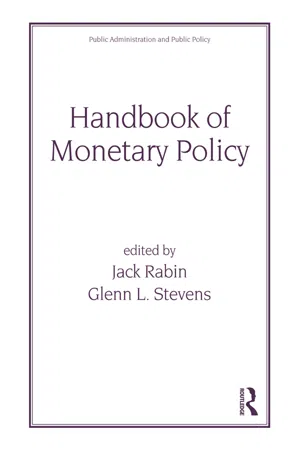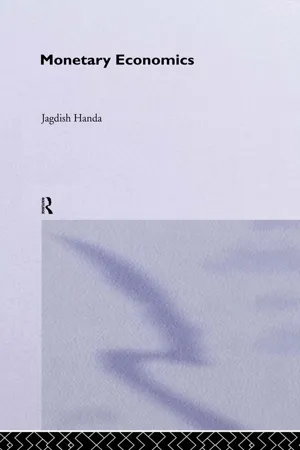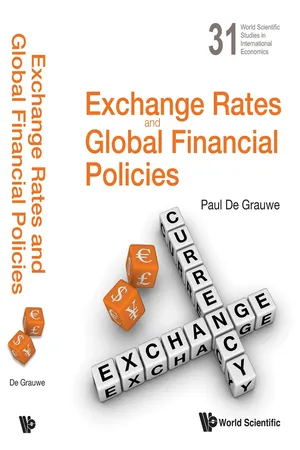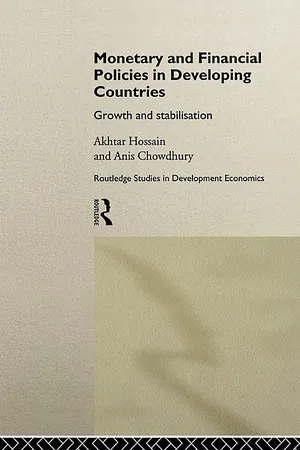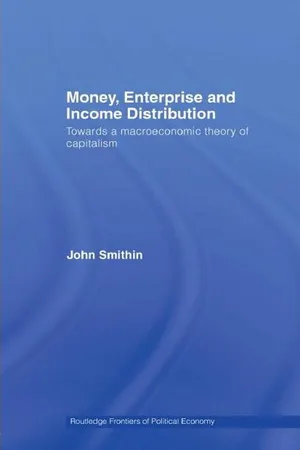Economics
Money Growth and Inflation
Money growth and inflation are closely linked in economics. When the money supply in an economy increases rapidly, it can lead to inflation as more money chases the same amount of goods and services, driving up prices. Central banks often aim to manage money growth to maintain stable inflation rates, as excessive inflation can erode the purchasing power of money.
Written by Perlego with AI-assistance
Related key terms
8 Key excerpts on "Money Growth and Inflation"
- eBook - ePub
- Jack Rabin(Author)
- 2020(Publication Date)
- Routledge(Publisher)
Monetary policy plays a key role in determining inflation rates. In the next section, we summarize the empirical evidence on the relationship between inflation and growth in a cross-section of countries. This evidence suggests a systematic, quantitatively significant negative association between inflation and growth. Although the precise estimates vary from one study to another, evidence suggests that a 10 percentage point increase in the average inflation rate is associated with a decrease in the average growth rate of somewhere between 0.2 percentage points and 0.7 percentage points.Some researchers are tempted to view this link as implying that if a country conducts monetary policy so as to lower its inflation rate by 10 percentage points, its growth rate will rise by anywhere from 0.2 percentage points to 0.7 percentage points. Obviously, the data alone cannot give us an answer to the policy question we care about. Therefore we explore the ability of various models with transactions demand for money to account for this association. We use the growth rate of the money supply as our measure of the differences in monetary policies across countries. Although many models predict qualitatively that an increase in the long-run growth rate of the money supply decreases the long-run growth rate of output in the economy, we find that in these models, a change in the growth rate of the money supply has a quantitatively trivial effect on the growth rate of output. The reason is that in endogenous growth models, changes in output growth rates require changes in real rates of return to savings, and it turns out that changes in inflation rates have trivial effects on real rates of return and thus on output growth rates.We go on, then, to broaden our notion of monetary policy to include financial regulations. We study environments in which a banking sector holds money to meet reserve requirements. We model banks as providing intermediated capital, which is an imperfect substitute for other forms of capital, and we consider three kinds of experiments. - eBook - ePub
- Jagdish Handa(Author)
- 2002(Publication Date)
- Routledge(Publisher)
The effect of changes in the quantity of money on growth can be examined in one of two ways. It can be estimated directly by using the data on the money supply or indirectly, since the growth rate of the money supply is usually related to the rate of inflation, by examining the effect of inflation on the growth rate of output. The theoretical findings on these can be summarized as:(a) the quantity of money is neutral in the long run;(b) any deviations from neutrality emanating from the analysis in sections 26.1 to 26.3 are minor (of a second or third order of importance, which may not be visible in the data or not invariant among different periods or countries); and(c) the long-run growth rate is independent of both the money supply growth rate and of the rate of inflation.However, some of the inflation-growth literature claims that high inflation rates are inimical to growth because they introduce distortions and inefficiencies in the economy. This literature further claims that price stability enhances economic certainty and promotes investment, which is conducive to growth.14 Hence, growth rates will be negatively related to the inflation rate.15Among the studies which report that the growth rate is independent of the rate of monetary growth and the inflation rate is Lucas (1996). Lucas plots for 100 countries the bivariate relationship between thirty-year averages of the output growth rate and the M2 growth rate, and argues that the plots show the former as being independent of the latter.16 His conclusion is that, in the long run, money is neutral for the output growth rate.McCandless and Weber (1995) used time-series data for 110 countries and thirty-year geometric average rates of growth. Their finding was that there was no correlation between inflation and output growth. Further, in general, there was no correlation between the growth rate of money – measured by M0, M1 and M2 – and real output.17 - eBook - ePub
- Paul De Grauwe(Author)
- 2014(Publication Date)
- WSPC(Publisher)
As is well known, the European Central Bank continues to assign a prominent role to the growth rate of the money stock in its monetary policy strategy. 5 The ECB bases this strategy on the view that “inflation is always and everywhere a monetary phenomenon.” 6 This may be true for high-inflation countries. Our results, however, indicate that there is no evidence for this statement in relatively low-inflation environments, which happen to be a characteristic of the EMU countries. In these environments, money growth is not a useful signal of inflationary conditions, because it is dominated by “noise” originating from velocity shocks. It also follows that the use of the money stock as a guide for steering policies towards price stability is not likely to be useful for countries with a history of low inflation. References Barro, R (1990). Macroeconomics, 3rd Edition. New York, NJ: John Wiley. Barro, R and X Sala-i-Martin (1995). Economic Growth. Cambridge, MA: MIT Press. Boschen, J and L Mills (1995). Tests of the relation between money and output in real business cycle models. Journal of Monetary Economics, 22, 355–374. Bresciani-Turroni, C (1937). The Economics of Inflation. London, UK: Allen & Unwin. Cagan, P (1956). The monetary dynamics of hyperinflation. In Studies in the Quantity Theory of Money, M Friedman (ed.). Chicago, IL: University of Chicago Press. Dwyer, GP Jr. and RW Hafer (1988). Is money irrelevant? Federal Reserve Bank of St. Louis Review, 70, 3–17. Dwyer, GP Jr. and RW Hafer (1999). Are Money Growth and Inflation still related? Federal Reserve Bank of Atlanta Economic Review, 84, 32–43. Fitzgerald, TJ (1999). Money Growth and Inflation: How long is the long-run? Federal Reserve Bank of Cleveland Economic Commentary. Friedman, M (1963). Inflation: Causes and Consequences. New York, NY: Asia Publishing House. Friedman, M and A Schwartz (1963). A Monetary History of the United States, 1867–1960 - Anis Chowdhury, Akhtar Hossain(Authors)
- 2003(Publication Date)
- Routledge(Publisher)
0 is the rate of velocity at zero inflation and ω is the coefficient on inflation. Substitution of equation (2.14) into equation (2.12) gives the following relationIt shows that inflation is not a linear function of economic growth. The ratio of inflation to economic growth rises with economic growth, which means that the greater the growth rate financed by money creation, the larger will be the marginal increment of inflation. A limit will eventually be reached at which inflation will approach infinity, such thatIt is the value when the denominator in equation (2.15) is zero. For example, when ω=10 (the case discussed by Mundell), to raise the growth rate by 1 per cent will require an acceleration of inflation by 57 per cent per annum. And the maximum growth rate possible is 1.5 per cent per annum when inflation approaches infinity.Inflationary finance and the danger of hyperinflation
The policy of inflationary finance has been criticised by Bailey (1956), Dornbusch and Reynoso (1989), Mundell (1965, 1971), Marty (1967, 1973), and Friedman (1971). The standard argument against inflationary finance is that it imposes welfare costs on money holders. However, the effective argument against inflationary finance in developing countries is that once a licence to print money is given to the government there is no guarantee that it will stop short of hyperinflation. Economists working on Latin American inflation history would testify that hyperinflation in Latin American countries was ‘triggered by large budgetary deficits and sustained by subsequent ongoing deficits, virtual economic collapse, and steadily rising inflationary experiences’ (Gillis et al.,- John Smithin(Author)
- 2013(Publication Date)
- WSPC(Publisher)
lower inflation. An increase in real wage (or other) costs, without a matching increase in productivity, will lead to lower growth and higher inflation (stagflation). An increase in productivity, itself, however, will do the opposite (it will produce higher growth with lower inflation).A “tight money” policy, in the sense of a higher real policy rate of interest, will reduce inflation but lead to lower growth, and vice versa for an expansionary monetary policy. An increase in Keynesian “liquidity preference” or “bearishness” in the financial markets, meanwhile, have the same effect on interest rates as a deliberate tight money policy (which, as mentioned, does seem to have been be one of the main points that Keynes himself was trying to get across in the General Theory ).The Potential for Outright Financial and Economic Instability
It is true that the results in the previous section pre-supposed that the monetary and fiscal authorities were pursuing a (somewhat) stable policy. What I mean by this is simply a policy of stabilizing the inflation-adjusted real policy rate of interest at (hopefully) some “low but still positive” level (Smithin, 1994, p. 201, 2003, p. 207). Frequently, when this sort of policy is suggested to academic economists (from all sides of the political spectrum), or to central bank and other government officials, financial markets participants, and others, the typical reaction is incredulity. Such a thing is “impossible”, they say. How can central banks ever be expected to control a “real” interest rate? However, as we specifically mean the inflation-adjusted real policy rate, there is really no mystery, and such a response cannot be anything more than the result of some previous period of “conditioning” in the precepts of classical or neoclassical economics. In reality, it is not at all impossible to stabilize the real policy rate in the above sense, and actually a very simple thing. All that it means is that the central bank is continually adjusting the nominal policy rate to keep the inflation-adjusted real rate roughly constant. In these sort of circumstances (that is, if central bank is pursuing this type of policy) then even if the fiscal authorities have been running a budget deficit, for example, the mere existence of the deficit does not lead to instability per se, in spite of traditional popular prejudices on the topic, now greatly reinforced by nearly half-a-century of similar arguments from the mainstream economics profession. On the contrary, we have seen above that an increase in budgetary spending against the background of a stable monetary policy, meaning precisely a policy that ensures the stability of real interest rates, will certainly increase the economic growth rate. Moreover, while it also increases the inflation rate it will not lead to runaway instability in either variable. (An increase is presumably a “good thing” in the case of growth, and not so good in the case of inflation.) Against the same monetary policy background, a tax cut holding spending constant, which also increases the deficit, will actually lead to higher economic growth with lower- eBook - ePub
- John Smithin(Author)
- 2008(Publication Date)
- Routledge(Publisher)
9 Endogenous money, monetary policy, and inflationIntroduction
It is always possible to present a macroeconomic theory purely in “real” terms, that is, focusing on the determination of the level of real GDP, or its rate of growth, as was done in the previous chapter. However, this is only half the story. It is also necessary to trace out the flows of money that must be occurring as the goods and service in the real economy are produced, and change hands. It was argued earlier that the monetary mechanism is an integral part of the way in which profit is actually generated in capitalism, and that, in fact, the so-called real economy could not function without it. Mention of money, in turn, brings up questions of monetary policy , and how this is related to both economic growth and inflation, and hence to such things as the traditional debate over “rules versus discretion” in monetary policy.In the fifty-seven years between Simons’s (1936) “Rules versus authorities in monetary policy” and Taylor’s (1993) “Discretion versus policy rules in practice”, monetary policy was usually thought of, by most mainstream academics, in terms of controlling the level or the rate of growth of one or other of the monetary aggregates, or perhaps just controlling the rate of growth of the monetary base. The purpose of this was to control inflation in accordance with the quantity theory of money. A monetary rule would refer to something like mandated limits on the rate of growth or whichever aggregate was thought to be the most likely to achieve this objective. Keynesian and Post Keynesian economists, however, have usually thought of monetary policy in terms of controlling interest rates (an issue that only very belatedly arrived on the orthodox agenda in the mid-1990s), and would be more interested in how monetary policy would affect (say) unemployment or growth than inflation. They would also, to some extent be more likely to favor a discretionary regime rather than a rules-based one. It is true that the modern mainstream monetary theory of the late twentieth and early twenty-first centuries reverted to a neo-Wicksellian regime for monetary policy, in which a short-term interest rate becomes the main monetary policy instrument and the money supply itself becomes endogenous. Nonetheless, when orthodox economists talk about interest rate rules for monetary policy, the presumption is still that the ultimate purpose of the rule is to achieve low inflation, stable inflation or even outright price stability. It remains the standard view that these sorts of things are what monetary policy is all about, rather than any potential impact on the unemployment rate or on economic growth. - eBook - ePub
- Mauro Baranzini, Alvaro Cencini(Authors)
- 2005(Publication Date)
- Routledge(Publisher)
GT: having a simultaneous effect on aggregate supply and demand, an increase in the available quantity of money cannot be called inflationary unless we look separately at the quantity of money and the volume of production. Inflation only appears when the (monetary) incomes increase faster than the (real) product. Although in principle supply and demand can only be measured in monetary units, within an equivalence relationship, inflation is considered as an excess of money over the available product. Or rather, the problem being too obvious to be completely concealed, inflation is identified with a situation in which the comparison between money and product at two different moments reveals a greater increase in the quantity of money than in the product. But of course the problem remains the same: how can we measure an increase in the production if it is made up of goods physically different? ‘The problem of comparing one real output with another […] presents conundrums which permit, one can confidently say, of no solution.’ (Keynes 1973:79).Of course we could be tempted to dismiss these problems as purely theoretical ones with no practical consequences whatever. But here the economic policy is at stake. In this perspective, the post-Keynesians are led to question the restrictions on money creation advocated by the Monetarists; according to them, it has a severe drawback: it will restrict indiscriminately the volume of cash without taking any account of the diversity of its uses. The increase in the quantity of money is not by nature an inflationary phenomenon: it is a necessity to start production and to increase production. Davidson’s parable of the two islands (Davidson, 1991:100) will illustrate this. Let us consider the first island on which 10 apples are available, whereas the supply of money reaches 10 one-dollar notes. If all the available dollar notes are spent on the apples, the price will be $1 per apple. Let us consider the second island on which 20 one-dollar notes and 10 apples are available. Assuming all other things equal, the Monetarists would conclude that the price per apple will be $2. Inflation appears each time the quantity of money is in excess relative to available goods: if the quantity of money had only reached $10, no inflation would have appeared on the second island. The problem is that there is no investigation whatsoever on the reasons why a greater supply of money is available on the second island. For example, it may be that the $10 in excess are spent on wages to workers employed for harvesting 30 more apples. In this case, the amounts to be considered are 40 apples and 20 dollars: the price for each apple will only reach 0.50 dollars. - eBook - ePub
- Stanley Bober(Author)
- 2016(Publication Date)
- Routledge(Publisher)
Indeed what is instrumental on the part of the central bank in influencing real output is not a monetary aggregate or a quantity, but its price; that is, the rate of interest. Placing this discussion within our steady state growth path, would have us “visualize” an accommodating central bank policy that thwarts bank liquidity pressure as the banking system meets the growing credit finance needs along the natural growth trajectory (we think of the growth rate of this money supply as being equal to the G n rate). Money, as we see it in terms of available debt financing, joins those other supportive forces sustaining long-term growth. Now let us get back to that exogenous variable, the rate of interest, which the central bank can determine through its open-market operations. Given the “price” of its choice, the Fed is prepared to supply the reserves necessary to support whatever the amount of bank loans demanded at that price; in other words, the supply of “money” is infinitely elastic, giving us a horizontal curve with respect to the given interest rate. Thus the ability of the central bank to control the growth of monetary aggregate depends on the ability to control the rate of bank lending (credit demand) via the rate of interest and not, to reiterate, through control of the monetary base. What is normally lost sight of, to repeat an operational point, is that when reserve requirements come into effect, the loans inducing such requirements have already been made. We illustrate our discussion in Figure 9.9. 18 In panel i we find an administered interest rate () on the vertical, with a corresponding level of credit finance demand (C d) on the horizontal, that translates into a level of the money supply (M ′) in panel ii. At the given interest rate the banking system will supply the amount of bank credit demanded (again note the interdependence of the demand for and the supply of money), while the central bank provides the money base induced by this increase in deposits
Learn about this page
Index pages curate the most relevant extracts from our library of academic textbooks. They’ve been created using an in-house natural language model (NLM), each adding context and meaning to key research topics.
